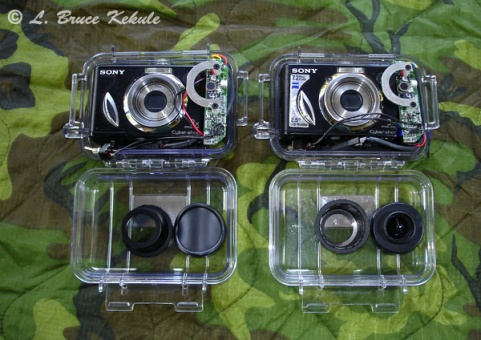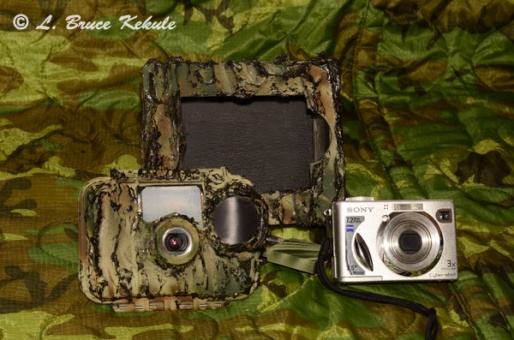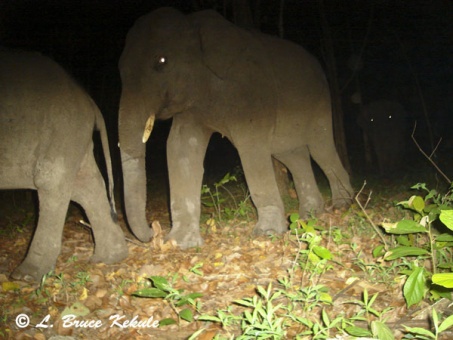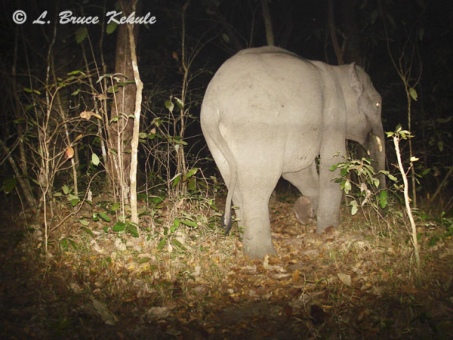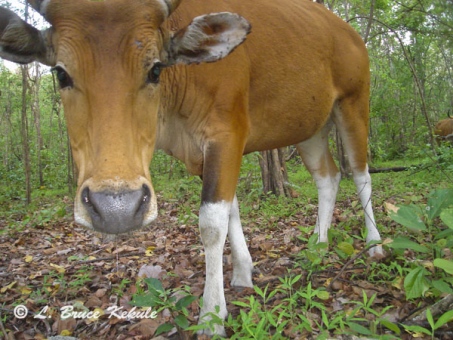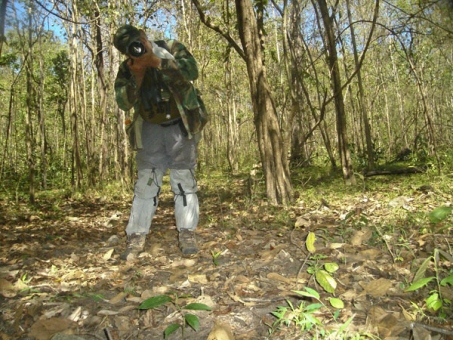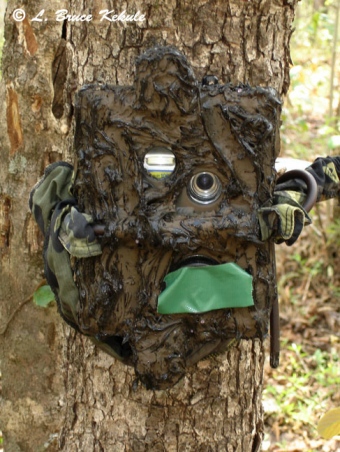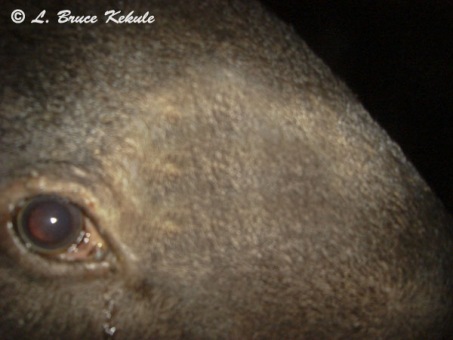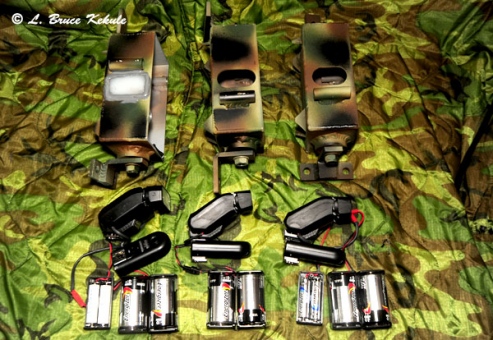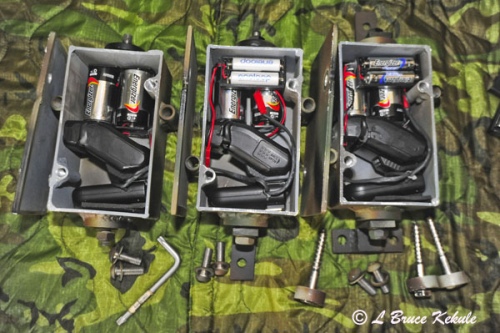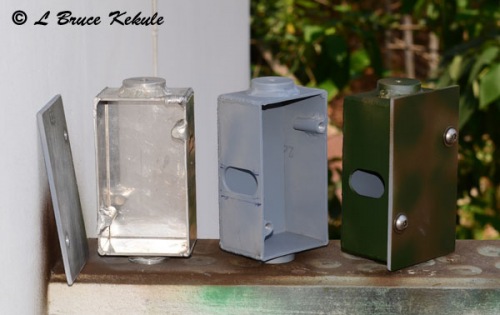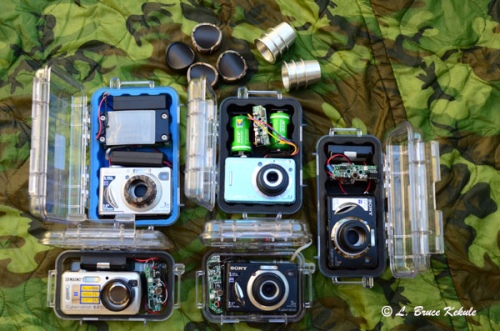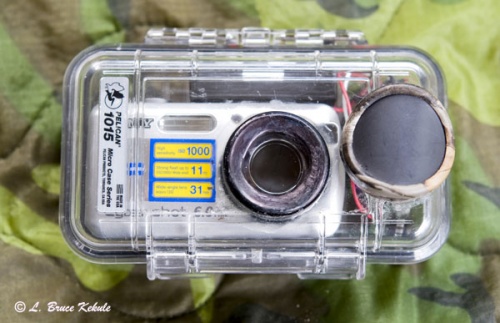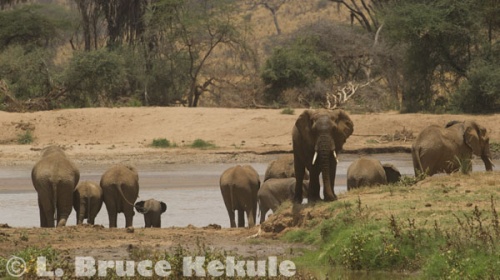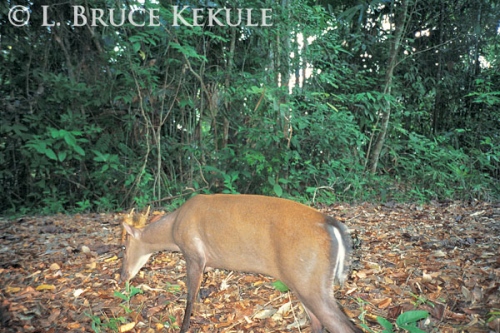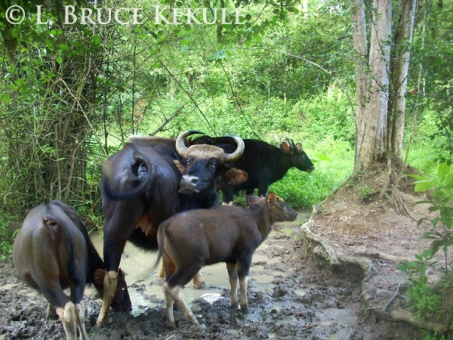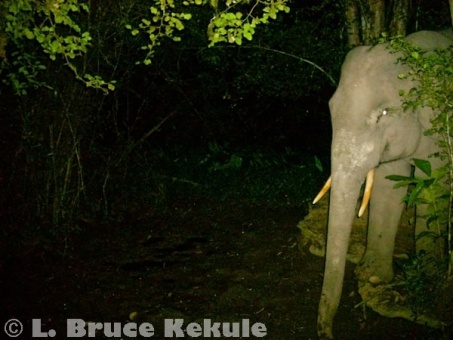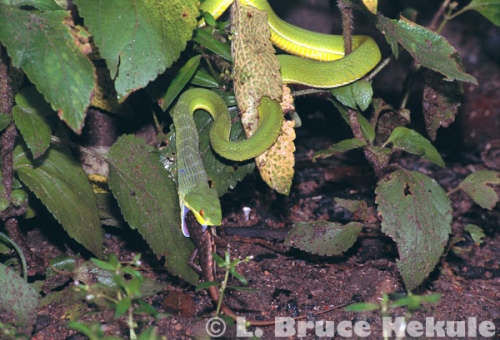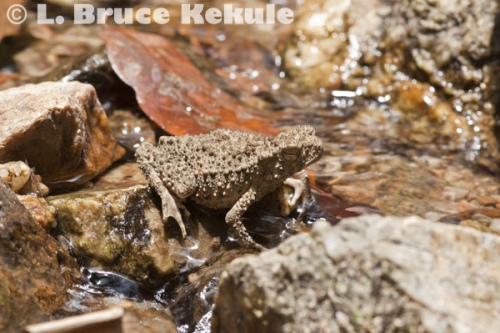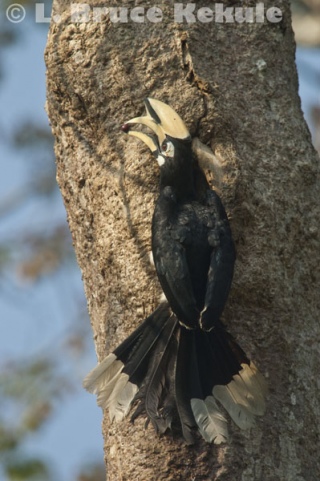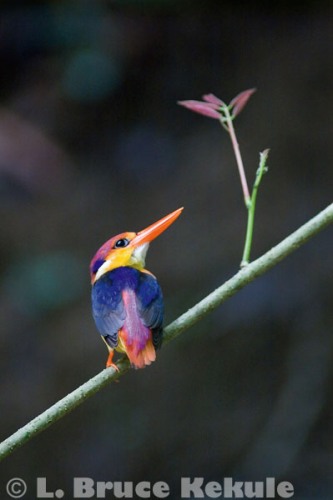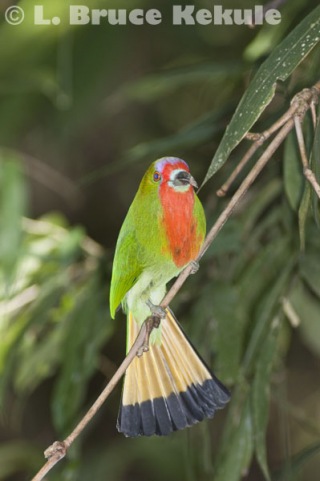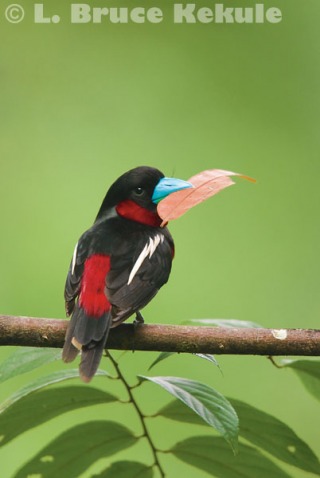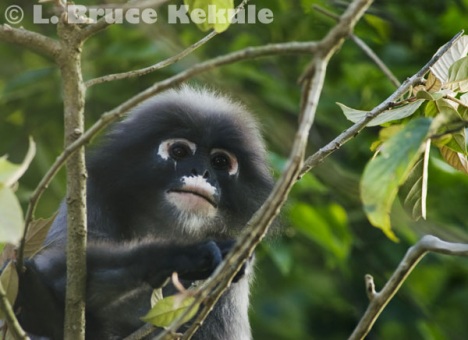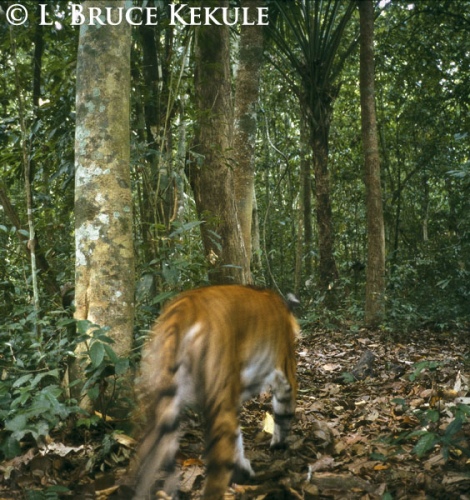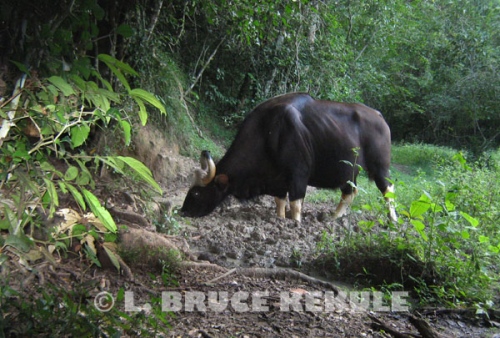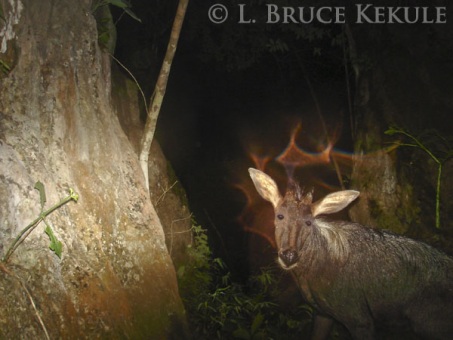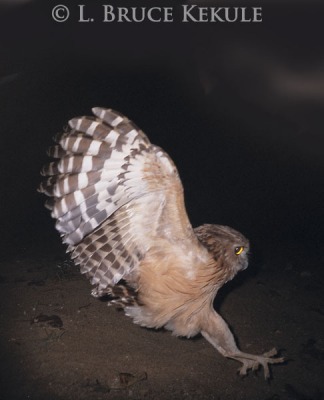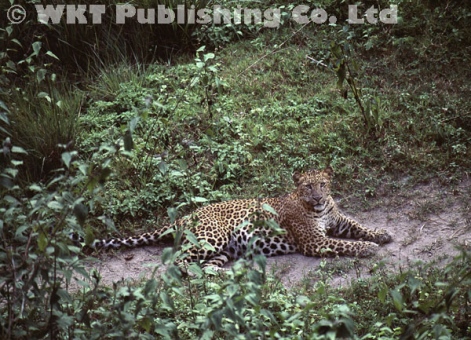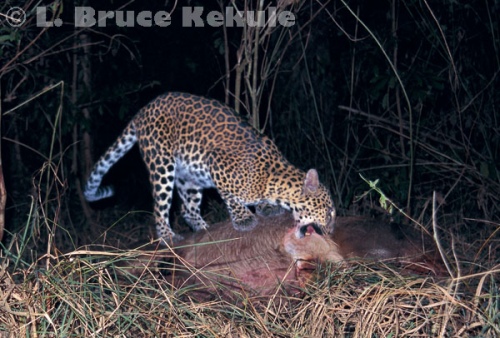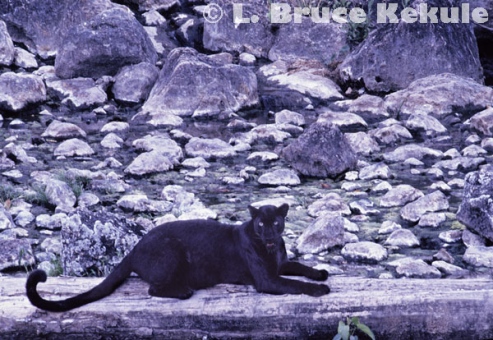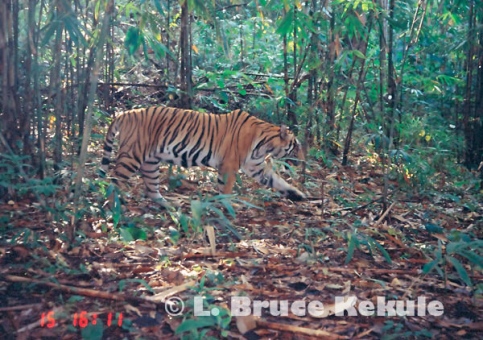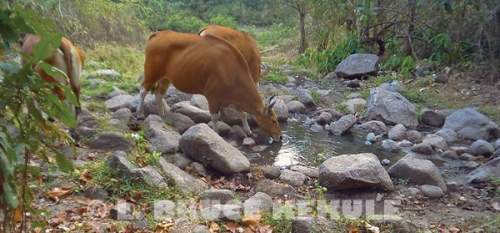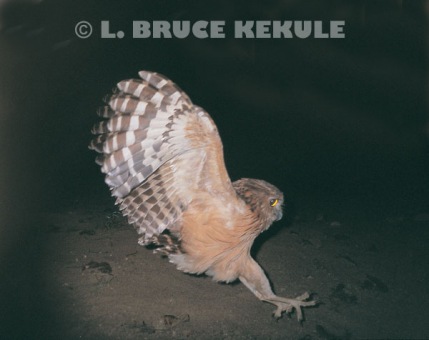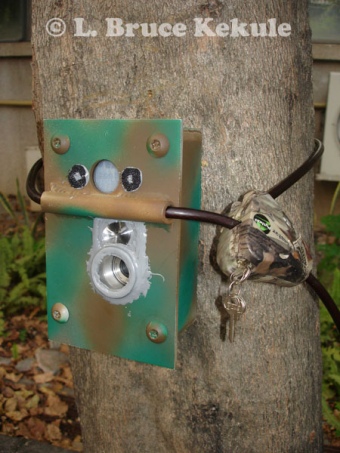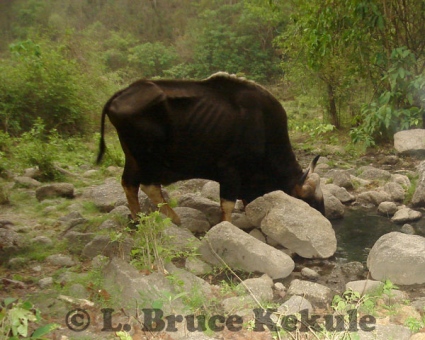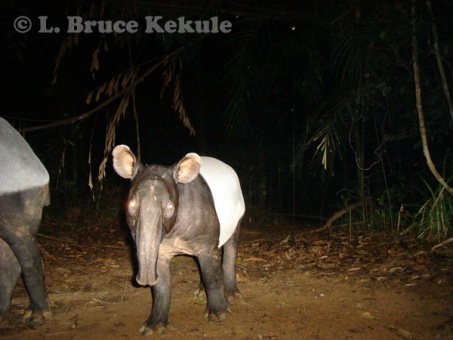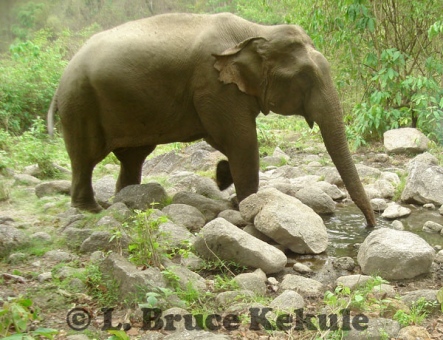Posts Tagged ‘camera-trap’
Two camera traps for Africa
LBK ‘Clear-View’ trail camera project: Twin W7/1010/SSIs
Sony W7s in Pelican 1010 cases with Snapshotsniper SSI boards
In 2008 when I first began building digital trail cams, I used several different models of Sony, Nikon and Canon cameras but found the Sony W7 to be one of the best producing very good quality photographs, both day and night, with its Carl Zeiss lens set to ISO 400 in ‘program’ mode. I actually use a W7 for general photography while in the field and have come to like this model even though it’s a bit large for a digital compact compared to newer models.
W7/1010/SSI components ready for building
The W7s are robust cameras that use two AAs and are fairly quick for all-round use. The only drawback; they are tough to hack and a steady hand, good eyes and nerves of steel is needed to modify these as the connections are tiny..! Check out Camtrapper.com and Buckshot164’s video tutorial on the W5-7, or the W1 for that matter (similar camera).
By using the Pelican 1010, they are truly ‘pocket size’. I normally use two ‘Energizer Lithium’ batteries that can usually last a month or more. I bought 8 W7s and built camera traps around six of them but kept these two for a special job one day.
W7/1010/SSI cam #1
I sourced the clear Pelican cases and managed to get some of Gary’s last SnapShotSniper ‘Simple Sniper’ boards before he discontinued them. I also ordered the metal sensor mount for easier installation with epoxy. By laying the camera and the 9-volt battery in the deep end of the case and the sensor in the shallow end, everything just fits.
W7/1010/SSI cam #2
The build is straight forward, and no hole is cut in the case for the flash allowing the camera to shoot straight through. A lens snorkel and HPWA is used and there are no externals. I have tested most of the cameras in this ‘clear view’ series and the power of the flash is not cut down by the case.
In fact on these builds as an experiment, I’ve installed a flash diffuser (cut from a Nikon SB26 flash diffuser) to cut back on harsh light sometimes caused by the factory flash. This idea came from an Olympus ‘dive housing’ for their U-700 digital compact shown here. My main objective with camera trapping is close frame filling shots that really show wildlife and the diffuser just softens the flash.
Olympus U-700 digital camera in an Olympus dive housing with a flash diffuser
A couple of aluminum boxes protect the W7s/1010s and a ‘Python’ 5/16” locking cable is used plus small ‘shark teeth’ are welded on the back to lock the cams in place on a tree. Holes are drilled to accommodate two lag bolts but these will not be used where I’m going, but later when I deploy these cams in the field here in Thailand. I have made-up one with 3D camouflage pattern and the other with 4-color camouflage paint job using fern leaves.
Completed trail cams ready for the field
I have built these two for my yearly African photographic trip that is coming up on May the 1st for two weeks. I will be going to Kenya once again, but this time will be visiting the great Amboseli (close to Mount Kilimanjaro) and Tsavo (East and West) national parks plus Shimba Hills Wildlife Sanctuary (especially after sable) and finally close out the safari at Nairobi National Park.
I hope to slip them in depending on local restrictions and laws, plus available wildlife and forests in the hotels and resorts where I will be staying on the fringes of the protected areas. In most reserves in Kenya, one is not allowed to leave the safari vehicle at any time or place other than in the hotels, and heavy fines can be incurred by the driver/guide (more than a $1,000 US dollars) if they are caught. It seems unjust but some people have already been maimed and even killed by this reckless behavior.
Detail of the drilled and taped box
In 2010, I slipped a trail cam in the bush and got a beautiful shot of a giraffe in Samburu National Park and then in 2011, got several shots of the rare bushbuck (both male and female), an African mongoose and a large-spotted genet plus a night patrol ranger with a .458 Winchester M70 express rifle at Siana Springs Tent Lodge near the Masai Mara Game Reserve. It was a neat experience.
Sony W7s and Sony S600 trail cams: ‘Python’ locking cable and camouflage sleeves.
These two Sony W7s and another Sony S600 are some of my smallest trail cams and just right to take with me while flying abroad. Being little, they are easily carried in my baggage and set-up will be quick. I will post any pictures at a later date.
Huai Kha Khaeng: A camera trap saga
Thailand’s amazing forest with some beautiful, elusive and rare Asian creatures
Huai Kha Khaeng Wildlife Sanctuary is situated in central western Thailand, and is a World Heritage Site. It is the top protected area in the Kingdom. In January 2012, I began a camera trap program to determine the status of wildlife found here. In just a short two months, all the large mammals including elephant, gaur, banteng, tapir, tiger, leopard and many others have been caught by ‘homebrew’ digital camera traps set at various mineral deposits, water holes and game trails situated in the interior of the sanctuary. I have ten trail cams working through till March 31st, 2012. These are the best series. The following photos shows this amazing biodiversity, and this place is truly worthy of its ‘World Heritage Site’ status.
Set-up Number 1: A S600/1010/SSI was set above a water hole close to a ranger station. This cam turned out the most wildlife photos over a two month period. This mineral deposit and waterhole is visited daily by many animals and is one of the best in the sanctuary.
A Sony S600/Pelican 1010/SSI in an ‘Elephant proof ‘ box with a ‘Python’ locking cable
Mature female tiger
Tiger follow-up shot
Young tusker elephant in a herd
Tusker close-up
Tusker about-face
Mature gaur bull
Mature banteng bull
Younger banteng bulls
Mature banteng cow
Banteng cow close-up
Macaque monkey
Camera trapper
Set-up Number 2: Another S600/1010/SSI was set close to the ranger station and a bag of large rotten fish heads was strung up to prevent being taken by a scavenger like a water monitor. Amazingly, a leopard and a big wild boar, both scavengers, came to the bait. The bag can be seen in the boar picture. Boy did it smell..!
S600/1010/SSI in ‘elephant proof’ box with python locking cable.
Leopard male in the stream attracted by the ‘fish head’ bait.
Wild boar hoping for some carrion.
A crab-eating mongoose in the stream after the bait had been cut down.
Set-up Number 3: An old Sony S600/1040/BFOutdoors/2 ‘C’ cell externals in an ‘elephant proof’ box and ‘Python’ locking cable with 3D camouflage was used to catch this tiger mother and her cub (also caught by Bushnell Trophy Cam video twenty meters away). Other shots collected from this cam were deer at night not included here.
Sony S600 in a Pelican 1040 and BFOutdoors board with 2 ‘C’ cell externals
Tiger mother caught close to Subkaow mineral deposit and water hole
‘Eye of a tiger’ as this young cub has a chew on the cam…remarkable shot…!
Set-up Number 4: An older S600 with a Yeticam board in a 2nd generation LBK aluminum boxed cam plus tools for installation. Tiger, tapir and a sambar stag came along this trail about a day’s walk from the ranger station I stay at. This site will be covered by long-range cams with ‘C’ and ‘D’ cell externals for a three-four month period during the rainy season.
Old 2nd generation LBK trail cam in an ‘elephant proof’
housing firmly bolted to a tree with a ‘Python cable and 2 lag bolts.
Rear-end of a tiger along a game trail
Asian tapir at night
Tapir up-close and checking out the cam
‘Eye of a tapir’….not as dramatic as a tiger’s eye..but OK for government work..!
A mature sambar stag, Thailand’s largest cervid
Note: I still have more then ten trail cams working here at the moment including my new Canon DSLR 400D with three wireless flashes, and two of my new W55s. I will also be setting up a homebrew video very soon. I surely will be posting many more camera trap photos of this truly wonderful and magical wildlife sanctuary in the near future.
Another pair of camera traps for the forest
LBK ‘Clear-View’ trail camera project: A pair of W55s but in different cases
W55s in a Pelican 1020 and Otter 2000 cases with SS II boards and 3 AAs
This project came forth with a need for trail cams that could last longer than my customary time of one month between card checks, battery and desiccant replacement. I wanted a camera trap to last at least two-three months without visiting the site. Digital cameras with ‘AA’ externals are the ticket. Over the rainy season would be a perfect setup from August to late October when the forests in Thailand are almost inaccessible due to swollen streams and rivers, and constant rain.
The Sony S600 digital camera has become increasingly difficult to find in Thailand and as of this post, none are available here. But the W50, 55 and 80s and other cameras in the ‘W’ series are easier to get being slightly newer. Actually, I believe the S600 has dried up because of the huge demand for them on eBay and the U.S. homebrew trail camera market.
Sony W55s in Pelican-Otter cases with SSIIs and AA externals
The second-hand camera shops in Bangkok are in ‘Chinatown’ and many have loads of different models to choose from. I picked up two W55s for a song, ordered a couple of Gary’s amazing little SSII boards, found a Pelican 1020 plus an Otter 2000, both in clear, and triple ‘AA’ battery packs for these two trail cams. Everything fit easily and I put them together in my shop.
I built two ‘elephant proof’ boxes from 3mm sheet aluminum and had my welder ‘Tig’ it all together. I now have incorporated half-inch alloy rods welded into the corners for a cleaner look, and then drilled and tapped for 10mm ‘power torque’ machine screws. Faceplates are machined for lens, flash and sensor from 3mm aluminum plate.
Back-end of ‘elephant proof’ boxes with Stainless 3″ lag bolts and washers
An aluminum tube is welded to the front for a Python 10mm locking cable and what I call ‘shark teeth’ are welded on the back to lock the cam in place on a tree. Two 3/8” x 3” stainless lag bolts secure it from inside the box and the backs are beefed up with ¼” plate where the bolts are (see photo). These units have proven to withstand the carnage handed out by wild elephants or poachers that sometimes can be a disaster waiting to happen.
There is a mineral lick more than a days walk from the ranger station I work out of in Huai Kha Khaeng Wildlife Sanctuary. I intend to set these two cameras plus a few others with externals at this location and let them work for a couple of months. This should be an interesting set and I will post photos and set-up when the time comes.
Conclusion:
Both units with an upgrade to 3 AA battery packs
Sony W55/Pelican 1020/Snapshotsniper SSII/3 AAs: This unit is for normal installation on a vertical tree housed in an aluminum box. A camouflage paint pattern was applied to the ‘elephant proof’ box. A ‘Python’ locking cable runs around the front and secures the unit in conjunction with two 3” stainless steel lag bolts and washers from inside the box.
Sony W55/Otter 2000/SSII/3 AAs: This unit being horizontal is better suited to fallen trees across game trails and other suitable locations that require special set-up. The ‘Python’ locking cable can be run both ways (horizontal or vertical) and hence is slightly more flexible in installation. Lag bolts lock the cam on a tree and the 10mm ‘power torque’ machine screws close up the faceplate making these tough to get into or off a tree.
Note: I originally installed two ‘C’ cells and when turned on, they began leaking in a couple of days but I saved the camera and board just in time and the camera’s finish got slightly blotchy. I also had to remove the lens door which now works very smoothly. I then removed the ‘C’ cells and replaced them with 3 AAs packs. The internal components are the same for both cams and alkaline AAs will be used for externals. I look forward to setting these two up sometime next week and leave them for two-three months, and of course, will post any photos at a later date.
A new DSLR camera trap
A Canon 400D trail camera with three Canon 270EX speedlights
This DSLR camera trap has been in the making for over a year but with many great opportunities now for tiger, leopard and other interesting wildlife photographs, I decided to finish it off.
DSLR Canon trail camera components
Canon 400D and ‘elephant proof’ aluminum box
Canon flash components
Close-up of wireless flash units
Machining flash boxes at my machine shop in Chiang Mai
Flash boxes in the raw, with a primer coat and camouflage paint job
Wireless flash trigger external modification
This Canon camera and flash units were assembled into an infrared camera trap using aluminum housings made in my shop at home in Chiang Mai. The main object of this project is to use multiple flashes and get some really great wildlife shots from this DSLR. The system works very well and it will be interesting to see what comes out.
Next week, I’m on my way to my favorite wildlife sanctuary in Thailand: Huai Kha Khaeng. I will be setting this rig where I have captured several tigers and leopard plus sun bear, gaur, banteng, elephant and a host of other animals that visit this mineral deposit and water hole. It should be interesting and I will post set-up and photos as soon as I get some (hopefully a tiger).
LBK ‘Clear View’ camera trap project
Building a modern digital camera trap
LBK ‘clear-view’ camera traps parts assembled
Recently, I wanted to up-grade my camera trap fleet using ‘Pelican’ cases available here in Thailand consisting of the 1010, 1015, 1020, 1030 and 1040 ‘Micro’ series. All of them were clear and I thought I would just coat them with camouflage paint when finished. After studying and collecting cameras, boards and externals, I began building this series of trail cameras around these clear boxes.
Camera trap #1 in the ‘clear view’ series
A Sony S600/Pelican 1015/SSII/2 AAs
Then it hit me. The practical aspect of this build is no need to drill an extra hole for the flash and just let the camera’s flash shoot straight through the box. A lens snorkel is used in every build and so there is no flash-bleed with the clear boxes.
I sourced all the components including Sony cameras depending on which Pelican case was used including a S600, W55 and several W5/7s. The infrared board is the SS1 & SSII plus one Yeticam board. Snorkels were machined from aluminum and a rubber gasket was made from Permatex black silicon sealant. SnapShotSniper ‘HPWAs’(High Performance Wide Angle fresnel lens) are used with one exception (the W5/1040/Yeticam using a standard wide angle lens).
Completed Sony S600/Pelican 1015/SSII/2 AAs
At most of my camera trap sites in Thailand’s protected areas, an aluminum box fitted around the Pelican case to protect it is an absolute must primarily from wild elephants, but also from theft. I use several 3” stainless lag bolts inside the box screwed into the tree (preferably dead) in conjunction with a ‘Python locking cable’ in 5/16” or 3/8” diameters. A 3mm aluminum alloy faceplate drilled for the lens, flash and sensor holes is bolted on to the front using stainless steel ‘power torque’ 10mm machine screws.
Power torque 10mm machine screws and wrench
This system has defeated many inquisitive jumbos who can destroy traps with extreme strength. These aluminum boxes are so firmly attached to the tree they just leave them alone after awhile. A friend of mine recently had three camera trap units with Python locking cables completely ripped off the tree and smashed by wild elephants in Thap Lan National Park in eastern Thailand because he used no lag bolts.
Fortunately for me, there is a custom motorcycle welding shop close to my house that offers ‘Tig’ welding of aluminum and I can have custom dimensions made up to fit any one of the Pelican cases I use. I do all the machining required in my shop at home. Aluminum is much better than steel being more lightweight and rust proof. Also, it is much easier to machine then tough old steel.
Completed camera trap and ‘elephant box’
I cut off the belt loops on the Pelican to make the boxes slightly smaller. I then do a 3D camouflage job on the outside box with black silicone sealant and paint with flat brown, tan and/or green to suit different tree bark colors and patterns. Pre-scouting of camera trap areas and photographing the trees to match-up the bark pattern can be accomplished.
Another aspect of using clear Pelican boxes is I can then use them in wildlife photography and camera trap workshops I occasionally do for Kasetsart University and the private sector in Bangkok. Camera trapping in Thailand with all its exotic animals is amazing and this series of clear boxes are my 4th generation camera traps (1st – generation were film cameras in aluminum boxes, 2nd – digital cameras in aluminum boxes and 3rd – Standard Pelican cases in aluminum boxes).
I hope this might help some people with bear problems in North America and elephant trouble elsewhere with access to ‘tig-welding’ equipment and a machine shop. I have completed the first trap shown here and will post the others to follow. This one is my favorite: A Sony S600/SS2/1015 with a single AA external. This small camera trap is just right for my day pack.
I will be setting this one next month in Huai Kha Khaeng Wildlife Sanctuary, a World Heritage Site situated in western Thailand. I now have ten digital camera traps and three video traps working in this forest and will post photos and videos as soon as I get back out from the field. I am extremely lucky to be able to work here.
The ‘Big Five’ in five days – Part Two
Africa’s great wildlife adventure – continued
Sunrise over Mount Kenya at ‘Sweetwaters’ Wildlife Reserve
The safari so far had been hectic and we had taken loads of photographs. On day seven, our next destination was a private reserve not far from Mount Kenya in the central provinces. The weather was crisp and chilly when we arrived at ‘Sweetwaters Game Reserve’. As we were checking into the lodge, a small herd of reticulated giraffe visited the waterhole next to the hotel. We left our bags and departed for our first game drive and saw more giraffe plus wart hog and zebra.
African fish eagle grabbing a fish – this was a setup where the locals call the eagles in and as they swoop down, the photographer is suppose to catch them in mid-flight. It was not easy and I burned a lot of card space but got one shot. Not easy!
This lodge is a tented camp and the services are amazing. In each bed, a hot water bottle is placed under the covers by the staff in the evening as the temperatures can sometimes drop dramatically during the night close to freezing. Mount Kenya is snow-capped year-round and the weather is always very pleasant here. The mountain is a beautiful sight when the cloud cover clears.
That night at dinner, a small herd of white rhino arrived followed by a family unit of elephant. Just about everyone left their dinner to photograph the huge herbivores. That night, I photographed a male impala that jumped the electric fence to nibble on the soft grass inside the hotel grounds.
Lion pride on the savanna
The next morning, I was up at the crack of dawn setting up my camera with a wide-angle lens to shoot the sunrise with the Mount Kenya range in the background. At 6:30am after a quick cup of coffee, we departed for the morning drive. We bumped into a mother lion and two small cubs. The female had a collar with a radio transmitter and was being monitored by the park’s research staff.
We left after lunch for the last leg of the safari. Our destination was several hundred kilometers to the east and Samburu National Reserve was entirely different from the three previous locations. It was lowland desert; hot, dusty and dry but still loaded with wildlife. The Samburu Game Lodge was very comfortable and located at the banks of the Eweso Nyiro River.
As we entered the park, a herd of giraffe crossed in front of us followed by a large herd of elephant that went down to the river for a refreshing drink and cooling bath. The African giants then sprayed dust over their backs to ward off insects.
Leopard mother and cub in Samburu National Reserve
Over the next two days, we managed to get leopard once again. This time it was a mother and cub feeding on a little male dik-dik, Africa’s smallest antelope. We also photographed Grevy’s zebra, giraffe, waterbuck, gemsbok and gerenuk plus the dik-dik. Elephant were everywhere and easily approached.
When the rains came earlier this year, the river overflowed its banks and washed out the only bridge in the park. We were not able to visit the other side where the lions and buffalo live. There were many crocodiles in this river and two would come up at night into a closed pen next to the bar in the lodge.
On our departure, we saw a large group of vehicles surrounding a tree and decided to investigate. It was on the way out. Up in a tree, a male leopard was sleeping off a previous kill.
African elephant herd in Samburu
It was strange how we bumped into a leopard on the first day and on our day out. The leopard is considered to be the toughest to see and photograph while on safari but we were lucky. The ‘spirits of the wild’ had smiled on us.
The long ride back to Nairobi took about 6 hours and we finally arrived at the hotel tired, dusty and hungry. The next morning we flew to Lamu, a World Heritage Site on the northeast coastline for some rest and sightseeing. This old town was a port during the slave-trading days and its rustic appeal off the beaten track was interesting.
Elephant family group by the Eweso Nyiro River in Samburu
These events are etched in memory and I know I have caught the African bug. I am leaving on another photographic safari to Kenya to catch the ‘Great Migration’ and when I return, will post a new story.
Such is the life of people hooked on photographing anything wild. It is the ultimate hobby or profession, and if you get a camera and start shooting Mother Nature’s creatures, do be prepared; it can be become an addiction.
A note to all who follow my website: I’m leaving for Africa in a few hours and ran out of time to finish this post. When I get back, I will add some additional photos of this amazing safari.
Keang Krachan: Rare creatures surviving in the park
A collection of photographs taken from 2001 to 2008
of some rare Asian animals still thriving in this amazing forest
Fea’s muntjac camera-trapped at Kilometer 33 on Phanern Thung mountain
Male muntjac also known as common barking deer at a mineral lick
Male muntjac feeding on leaves
Gaur cow at a mineral lick in the interior
Small gaur herd at another mineral lick
Gaur bull and cow footprint compared to my hand
Asian tapir swimming in the Phetchaburi River
Tapir camera-trapped near the Phetchaburi River
Serow camera-trapped on old logging road
Tusker camera-trapped at a mineral deposit at kilometre 12
Tuskless bull elephant in ‘musth’ camera-trapped on an old logging road
Tiger camera-trapped at a mineral lick in the interior
Indochinese tiger camera-trapped by the Phetchaburi River
Asian leopard camera-trapped on a nature trail
Indian civet caught near Ban Krang campground in the park
Banded linsang camera-trapped on a dry streambed
Banded palm civet camera-trapped by a stream deep in the interior
A king cobra hunting for prey by the Phetchaburi River
A green pit-viper and carpenter ant on a small tree
A green pit-viper swallowing a skink
Reticulated python on the road in Kaeng Krachan
Horny tree frog in a stream deep in the park
Giant tree frog further upstream
Great hornbill flying out of a fruit tree
Oriental Pied hornbill feeding its chicks at the nest
Wreathed hornbill at a nest
Oriental dwarf kingfisher near it nest
Pied kingfishers with a fish on a tree branch
Blue-bearded bee-eater with a beetle for its chicks
Red-bearded bee-eater close to its nest in a sandbank
Black-and-red broadbill with a bamboo leaf
Black-and-red broadbill building a nest
Javan Frogmouth by the Phetchaburi River
Lesser fish-eagle chick exercising its wings high up a very tall tree
Lesser fish-eagle mother and chick on the nest above the Phetchaburi River
Lessor fish-eagle on a tree branch behind my blind over the Phetchaburi River
River carp in the Phetchaburi River
Gibbon hanging from a bamboo on Phanern Thung mountaintop
Dusky langur near the Phanern Thung ranger station
Stumped-tailed macaque by the river
Rainbow over the Phetchaburi River
Kaeng Krachan National Park is an amazing place but is fraught with poor management and protection. There are many other animals and ecosystems not shown here but this place is truly one of Thailand’s greatest protected areas.
It takes lots of hard work to get down to the river and collect photographs of the creatures thriving there. But diligence, determination, the right equipment, money and with good guides, is also within the reach of serious amateur photographers or naturalists who just want to look.
The opportunities are endless. It is hoped these photographs will create awareness and help this place survive into the future, so that generations to come can also enjoy the beauty of nature in Thailand’s largest national park.
My next post will be a collection of photographs from Huai Kha Khaeng like this of that amazing World Heritage Site, and hopefully sometime before I travel to Africa for a safari to Kenya in mid-August.
Wildlife Candid Camera-Update: Photographing rare creatures with modern digital wizardry
Trail cameras catch Thailand’s cryptic wildlife
Indochinese tiger camera trap abstract
Camera trapping has been around for over a century when George Shiras III making history used the first flashlight camera triggered by trips wires in 1906. In the late twenties, two other men, F.M. Chapman and F.W. Champion, used pressure plates to activate their cameras. National Geographic and other magazines published many photographs from these early pioneers’ work.
In the 1970s, the first commercial camera trap was produced by TrailMaster.com using ‘active infrared’ to control the cameras followed by CamTrakker.com that used ‘passive infrared’ controlled traps to set off their cameras. Both companies incorporated simple point-and-shoot film cameras from Olympus and Yashica to capture photographs of wildlife.
Asiatic sun bear in Kaeng Krachan
Active infrared uses a beam between two separate units (transmitter and receiver hooked to a camera) and when the beam is broken, the camera is tripped. One the other hand, passive infrared detects motion within a given area covered by the sensor and will trip the camera when movement is detected (much like the sensors above automated doors in shopping malls and convenience stores). Both systems have merit and used in the right situation work equally well.
These first early-production units were designed and used by hunters in America to scout areas for deer, turkey and bear prior to hunting season. This in turn helped them to indentify trophy animals and movements of game in a given forest.
Gaur bull at a waterhole in Huai Kha Khaeng
It was not long before wildlife researchers found camera traps could also benefit their work with a photograph, plus the time and date, allowing them to create an extensive database of the animals living is a certain area. Behavior, presence/absence and other aspects of mammals, birds and reptiles are recorded.
Gaur cow at a mineral deposit in Kaeng Krachan
Wildlife photographers have also used camera traps to capture images of rare, endangered or cryptic creatures. Some have used simple camera-traps but others have incorporated high-end SLR or DSLR cameras with several flashes.
Banteng bull and forest flies in Huai Kha Khaeng
Steve Winter with National Geographic Magazine got an amazing photo of a snow leopard using a Canon DSLR and three Nikon flashes that won the Wildlife Photographer of the Year contest in 2008. The following year, a camera trap photograph of a wolf jumping over a fence won first prize but was later disqualified as the carnivore was domesticated and trained to jump. The organizers of this prestigious event should put camera trapping into its own category.
Banteng cows at a waterhole in Huai Kha Khaeng
The homebrew ‘Game Cam’ or ‘Trail Cam’ as it is now known by its users in the U.S.A. is a unique device with some units very high tech in its features, yet simple to operate and enjoy for just about anyone that has an interest in capturing photographs of wildlife.
Wild water buffalo caught by the Huai Kha Khaeng
The popularity of these cameras has grown at a fast pace over the last few years and opened up a number of usage possibilities to the users. There is also a huge ‘home-brew’ market for the do-it-yourself enthusiast plus the ready-made models that are available for those with a larger budget and no time to build one.
Serow in Sai Yok reserved forest
Camera traps have become very sophisticated and most now use some form of digital camera incorporated into the housing. There are now many companies producing them for less than one hundred U.S. dollars up to $900 or more. Some are fair and some quite good but many are not suitable for the tough conditions found in Thailand’s forests, especially the lower cost models.
Sambar stag in Khlong Saeng
As a wildlife photographer and due to the high cost of buying and importing commercial models into Thailand, I decided to produce my own camera traps. In the beginning, I used passive infrared circuit boards obtained from ‘Radio Shack’ in the U.S and had my close friend Yutdhana Anantavara from Chiang Mai, an electrician working offshore in the Gulf of Thailand, to hook-up the delicate electronics and modify some simple ‘point and shoot’ film cameras (Olympus and Canon).
To stand-up to the rigorous conditions in a Thai forest where moisture, invading insects and elephants can destroy plastic bodied camera traps, I designed and built the housings from aluminum at my machine shop in Chiang Mai.
Buffy fish-owl landing by the Phetchaburi River
A local welder TIG welded-up the box and I machined it flat. By using silicon sealant available at most hardware stores between the box and the flat faceplate, and by using large 10mm machine screws to get a tight seal, sealing is 100 percent. These have defeated many inquisitive elephants.
A small bag of silica gel (desiccant) is inserted in the box to protect the delicate circuit boards, cameras and film from moisture. I tested them on feral cats that walked on a wall at the back of my shop with some good results. These early models worked very well and I then decided to deploy them in the forest.
Feral cat camera-trapped behind my shop in Chiang Mai
In mid-2003, I set six camera traps in Sai Yok National Park in western Thailand by wildlife trails and waterholes. Every month, I would visit the traps and change film, batteries and desiccant. After four months, I finally got my first tiger, and then a second cat a few days later up on a 600-meter ridgeline. All the hard work and expense finally paid off.
It was the beginning of a program to catch the tiger on film. Other animals caught in Sai Yok were elephant, sambar, barking deer, wild dog, wild pig, serow and stumped-tailed macaque. I even managed to catch a water monitor on one camera.
Indochinese tiger by the Phetchaburi River
Even some poachers and hunting dogs were captured on film. One of those original film cameras is still working in the field and I named it ‘Tiger Cam’ as it caught my second tiger.
I then moved down to Kaeng Krachan National Park in the Southwest where I spent three years camera trapping wildlife to establish a presence/absence program in conjunction with Worldwide Fund for Nature (WWF-Thailand provided funding), and the Department of National Parks granted permission.
Gaur cow and calves in a mineral deposit in Kaeng Krachan
At that time, many tigers and leopards plus loads of prey species were thriving by the Phetchaburi River and a few of its tributaries, and many photographs were obtained over the course of the survey indicating a healthy ecosystem. Both prey and predator were living in natural harmony. I shut down the program after poachers stole three units near the headwaters of the river that was both costly and disappointing.
Sometime in 2007, my good friend Chris Wemmer, the Camera Trap Codger, who is now retired from the Smithsonian Institute, was the first person to tell me about a new company in the US producing infrared circuit boards and other accessories for the home-brew digital camera trap market. The company is Pixcontroller.com. Unfortunately, they no longer offer parts but now sell complete units with digital camera and video.
Asian wild dogs by the Phetchaburi River
A quick look on the Internet, and several companies offering boards and components to build ‘homebrew’ trail cameras are on-line. The best and the most reliable are boards from Snapshotsniper.com and Yeticam.com. The list for complete units is long and is best searched on the web.
I finally purchased some of the new high-tech boards and made-up some new traps using Sony ‘point-and-shoot’ digital cameras. These were modified by EDI, a company based in Bangkok to work with the electronic boards. The aluminum cases remained the same as the early production units as the best option for durability, and against moisture and elephants.
Tusker camera trapped at a waterhole in Huai Kha Khaeng
The first units were set-up at several mineral deposits deep in the forest of Kaeng Krachan National Park over a three-month period from October to December 2008. Animals digitally captured were tiger, elephant, gaur, sambar and muntjac. One camera had over 300 captures in one month at a mineral lick of elephant and gaur.
I then moved down to Khlong Saeng Wildlife Sanctuary in Surat Thani, southern Thailand and in the first part of 2009, began a new program setting both film and digital camera traps deep in the interior. Elephants, gaur, tapir, wild pig, sambar, muntjac, golden cat and Argus pheasant were captured.
Giraffe caught in Samburu Game Reserve in Kenya, Africa
This year in September, I made a trip to Kenya, Africa and took two camera traps with me. Due to the strict regulations about exiting the safari vehicle, it was difficult to set them up. But at one location, I was able to install one by a game trail. In four hours, a giraffe and elephant passed the camera. It showed how well these cameras can record passing wildlife, and the giraffe photograph shown in the story is the best one.
LBK camera trap using Sony W7 with a ‘Yeticam.com’ infrared board
in aluminum case with ‘Python’ locking cable
I now have more than a dozen digital camera traps using primarily ‘Sony S600 and W7’ cameras. They have been the best and most durable due to the manual features like ISO and f-stop adjustments, and compatibility with the infrared boards. Picture quality with the ‘Carl Zeiss’ lens is very good in the daytime and quite good at night.
The latest craze for camera trappers is ‘infrared capture’. The photos however are a greenish black and white, but are quite good for identification and scientific work. This system is unseen by animals and reported not to disturb them as a conventional flash.
Poachers and dog camera trapped in Sai Yok National Park
Video is another option. I now have two ‘Sony Handy Cams’ set-up with ‘Lanc’ video infrared boards that work very well. One is for daytime only and the other set to ‘night-shot’ with an infrared filter over the video light. Both work together at the same location over the course of a month between battery changes and downloads. It is just another option for those needing wildlife images, whether stills or movie.
The modern digital camera trap has allowed me to capture/recapture many rare and cryptic creatures on their own time, and in their own habitat. As wild animals continue to disappear, more protection, research and understanding are needed to save the natural world.
It is my main priority in life to educate all levels of society on what the Thai nation still has in regards to wildlife and the protected areas, and the need for proactive response to all the dangers facing Mother Nature. We must act fast to illuminate these threats to the Kingdom’s natural world so present and future generations can see, enjoy and cherish this wonderful heritage.
The Asian Leopard: Thailand’s second largest cat
WILD SPECIES REPORT
An ambush predator – solitary, stealthy and naturally camouflaged
The late French poet Robert Desnos (1900-1945) wrote a short poem entitled “The Leopard”
“If you go into the woods, beware of the leopard.
He meows in subdued voice and arrives from nowhere”
Black leopard in the late afternoon sun
The leopard Panthera pardus described by Linnaeus in 1758 is the second largest cat in Thailand. Once upon a time, leopards could be found in all the forests of the Kingdom. These felines are still surviving quite well in protected areas in the West, and some in the South. The central, eastern and northeastern regions have no reports of leopard for some time now.
A few have been reported in Phu Khieo Wildlife Sanctuary in Chaiyaphum province, but for some reason they have disappeared from most remaining forests. The reason these areas have no leopards are quite simple; prey species has been hunted out including the leopard itself for its pelt and bones, and encroachment has destroyed much of its habitat.
Sighting a leopard in Asia is extremely difficult, and even catching a rare glimpse of this very essential top predator is tough due to its solitary and stealthy behavior. However, luck can sometimes play an important part in viewing the leopard and I feel lucky to have seen and photographed them on quite a few occasions.
Leopard camera trapped in Kaeng Krachan National Park
The most thrilling or heart stopping adventure with a black leopard happened in Huai Kha Khaeng about five years ago while I was sitting up on a bluff overlooking the river. A photographic blind was erected on the rock-face about 20 meters up with a small trail that enabled me to get into the hide. It was a neat location that I had dreamed of sitting here for many years prior. The sun was bright and the weather was warm during the dry season.
About 9am, several monks down by the river passed on but did not see the camouflaged structure as they went their way. After that, I came down for lunch and set some camera traps at a mineral deposit nearby. At 2pm, I settled back in the blind and began a vigil of the river. I started to feel a bit groggy as the sun was beating down on my position. I moved my camera in to save it from the direct sunlight.
All of a sudden, I was startled by a guttural growl outside the enclosure. I stood up slightly and peering out the window came face to face with a huge round black head and yellow eyes about two meters away that penetrated my soul. My first instinct reaction; it was a big black dog. But that quickly changed as the creature stared intently at me before bounding down the trail it had come up. The big cat was gone in a split second. Of course there was not enough time to get any photographs. The incident surely is etched in my memory.
Black leopard camera trapped in Kaeng Krachan
Why had the leopard come so close without smelling me? On that particular day, I was using an old hunters technique by collecting fresh wild water buffalo droppings and putting them in front of the blind, and that probably covered my scent. Maybe the leopard thought there was a newborn calf, or an old weaken animal. Or maybe it used this natural place overlooking the river to spot prey like sambar, barking deer or wild pigs that are abundant here and came up to investigate. The vantage point is on a bend in the river and one can see for quite a distance both ways.
I will never know how close I came to being attacked by a leopard but it was a heart stopper for sure. I sat motionless for quite sometime. Only a few sticks and camouflaged material separated me from a wild creature armed with fangs and claws. On that day, the spirits of the forest looked after me, or was it the ‘Spirit of the Forest’. I like to believe that was the case. I hope one day to go back and stake out this bluff, and believe this leopard is probably a resident around here. Previously, I camera trapped tiger and a yellow phase leopard not far from here.
A leopard resting on a wildlife trail
Speaking of leopard attacks, my close friend and associate Dr Lon Grassman was once seriously injured in Kaeng Krachan National Park, Phetchaburi province by a leopard while working there on a survey to camera trap and collar the big cat. When Lon released one, it looked up and turned on him in a split second mauling his legs and arms. It was a close call but he survived to carry on his work researching wild carnivores. Lon established the home range and other behavior patterns of leopards in the park.
He then moved to Phu Khieo Wildlife Sanctuary, Chaiyaphum province in the Northeast and continued this work catching and releasing quite a few golden cats, clouded leopards and a marbled cat. He eventually received his doctorate for his excellent work.
In the beginning of my profession as a wildlife photographer, I was very fortunate. The Director of the Wildlife Conservation Division of the National Parks Department (DNP) at the time, my dear friend Dr Viroj Pimmanrojnagool (now retired), had confidence in me and gave permission to enter the realm of the leopard and the tiger, something not easily acquired. Entry into wildlife sanctuaries has always been very restricted but is possible with the right qualifications. Viroj and I are still very close and I visit him from time to time at his durian farm in Surat Thani down south where he is happily enjoying retirement.
Leopard in the bamboo – my very first photo of the big cat
My first encounter with the sleek cat goes back to the beginning of my career more than a decade ago. Driving into the forest late one afternoon in Huai Kha Khaeng Wildlife Sanctuary, a World Heritage Site, the sun was low but the light still quite good for photography. The protected area is situated in Uthai Thani province and is part of the Western Forest Complex.
I was about to capture my very first Asian leopard on film. This was in my early days as a wildlife photographer with a newly acquired Nikon N90s camera and 300mm lens. I was on a learning curve that would take me into some unique natural habitats and bump into some very unusual animals around Thailand.
Leopard posing in Kaeng Krachan
About 4pm some 10 kilometers from the headquarters as I was driving in, a leopard jumped in front of my truck and bounded up the steep embankment on my right. I gently came to a halt and there looking down at me was these two big yellow eyes that brought my attention to 100 percent. In the meantime, I had already grabbed my camera and started snapping through the window as fast as possible but quickly slowed the pace concentrating on focus. After a few more shots, the spotted cat melted into a bamboo thicket and was gone. The encounter was measured in mere seconds.
I sat in the vehicle for a few minutes to catch my breath as my heart was thumping. A close encounter with a carnivore capable of tearing us apart is something that can get the blood flowing. I finally got going again as my destination was still a couple of hours away deep in the forest.
Leopard on a sambar kill – my first camera-trap photo of the feline
Arriving at the Kabook Kabieng ranger station just at dusk, the head of the station Loong Waitanyakarn, another good friend, came immediately to the truck and said, “ a sambar mother and fawn have been killed by a leopard or wild dogs not far from the station and let’s go look”.
It didn’t take me long to ponder that an opportunity had presented itself. I had a new infrared sensor for my Nikon camera and decided to set-up the unit next to the dead sambar. A new role of film was loaded and the lens focused on the mother deer. The sensor was active infrared that uses a transmitter and receiver hooked to the camera. When an animal trips the beam, the shutter is activated taking a self-portrait. At the time, this technology was rather new but I needed it to supplement my regular photography.
Black leopard posing for me at a hot spring
The next day at noon some 10 kilometers away, Loong took me to a tree stand over-looking a hot spring. The box-like structure was quite high up and it was a bit scary getting situated in the blind but finally, I settled down with my Nikon 500mm lens and camera scheduled for a three-day stint. The mineral deposit and hot springs attracts many large mammals including elephant, gaur, banteng, tiger, leopard, wild dogs, tapir and many other animals that come for the life-giving minerals, or for prey.
Black leopard at the hotspring
About 3pm, a troop of leaf-monkeys visited the hot springs for a quick drink but did not stay long. They had been spooked by something as they all panicked and gave flight in the trees up the hill. A short time later, a black leopard appeared from the top end and walked over to where the monkeys had just been. The sun was low in the sky and I could see the leopard’s pattern of rosettes through the lens that jumped out at me.
My heart began racing as the stealthy cat stopped at the top to take a drink. It stayed for about an hour. I calmed down but continued shooting changing several rolls of film and watching this magnificent creature. Just before the sun was gone, it moved closer to the tree I was in and then walked across the stream. The cat plopped down on a log and stretched out posing for me, all the while looking up at my position. I kept shooting and then it came even closer before veering off probably spooked by my scent. As the leopard moved through the forest, monkeys, barking deer and sambar barked at the predator.
Leopard mother and cub camera trapped at a sambar kill – A rare photo
showing both color phases
I will never forget these encounters. Three leopards in two days are pretty good going for a new wildlife photographer and it was truly the beginning of many sightings and photographs of this amazing carnivore. I have seen loads of them on film while working in Kaeng Krachan. Both black and yellow phase were camera trapped in three separate locations in the interior at almost every location.
The Tenassarim Range in southwest Thailand is an absolute haven for the leopard due to a very good prey base here. Tigers also survive and have overlapping territories with the spotted cat. Both species hunt during the day and night. My old friend Suthad Sapphu, a forest ranger in Kaeng Krachan, was extremely helpful while we were camera trapping the big cats.
Leopard track in Kaeng Krachan
Without doubt, the future of the leopard depends on one thing only – the complete protection of the remaining forests where they live. If the national parks and wildlife sanctuaries remain intact with a high number of prey species, the big cats will survive. But if over-development, poaching and encroachment are allowed to continue, the large cats will eventually disappear.
Unfortunately, too much time and money is wasted by too many organizations talking about saving wildlife and their habitats, with very little actually being done. Human population growth will eventually destroy most wild places. Only true protection by some dedicated people will slow the destruction of nature’s precious wildlife and wilderness areas. It is hoped the leopard, and the tiger, will continue to survive as they have for millions of years.
Leopard Ecology:
Pound for pound, the leopard can take on some seriously large animals several times its size. The leopard is closely related to the jaguar of South America. Both have a spotted coat pattern, incidence of ‘melanism’ or black phase, and relatively short legs.
The present distribution of the leopard is restricted to Asia Minor, India, Southeast Asia, the Himalayas, Tibet, China, Siberia, and Africa. Fossils of leopards were found in Pleistocene deposits throughout Europe, the Middle East, Java, and Africa, some 1.5 million years old, indicating the leopard arrived after the tiger. These secretive cats are mainly nocturnal but in some localities, they are active in the day too. Their populations and ranges are difficult to determine but radio tracking of collared animals has shed new light on their movements and areas they live in.
Black leopard camera trapped in Kaeng Krachan
The leopard is a member of the Felidae family and is the smallest of the four “big cats” in the genus Panthera, or roaring cats. The other three are the tiger, lion and jaguar. The leopard’s range of distribution has decreased radically because of hunting and loss of habitat. It is now chiefly found in sub-Saharan Africa; there are also fragmented populations in Pakistan, India, Sri Lanka, Indochina, Malaysia, and China. Because of its declining range and population, it is listed as a “Near Threatened” species by the IUCN (International Union for Conservation of Nature).
The species’ success in the wild is in part due to its opportunistic hunting behavior, its adaptability to habitats, human settlements and activity, its ability to run at speeds approaching 58 kilometers per hour (36 mph), its unequaled ability to climb trees even when carrying a heavy carcass, and its notorious ability for stealth. The leopard consumes virtually any animal it can hunt down and catch. Its habitat ranges from rainforest to desert terrains.
Wildlife Candid Camera – Infrared cameras ‘trap’ Thailand’s elusive wildlife
Wildlife Candid Camera – Infrared cameras ‘trap’ Thailand’s elusive wildlife
Indochinese tiger camera trapped in Sai Yok National Park
One evening as the shadows were melting into darkness in the jungle of Sai Yok National Park, an Indochinese tiger Panthera tigris corbetti was meandering up to a forest pool for his evening drink. At the planned position, a camera-trap mounted on a dead tree tripped a photograph of the cat, causing it to bound into a bamboo thicket. The tiger could not of course have understood exactly what had just taken place. Instinct triggered its reaction to the flash and the camera’s mechanical click. Taking a photograph of a tiger in the wild is a very daunting task but the wizardry of modern electronics has made the job much easier.
Gaur herd caught at a mineral deposit in Kaeng Krachan National Park
A few days later and just two kilometers away, another tiger pads slowly through the forest topping a 600-meter-high ridge in late afternoon. Its senses are on high alert for any movement or sound that could lead to its next meal. A passive infrared camera-trap set on a wildlife trail catches the tiger as it passes through an invisible motion-detection field. The time and date is recorded and the wildlife photographer has just triumphantly photographed one of Thailand’s rarest mammals in the wild – without even being there at the time; a rare candid wildlife photograph set off by the subject itself.
Mother and cub in Huai Kha Khaeng Wildlife Sanctuary
Far away in Huai Kha Khaeng Wildlife Sanctuary in Western Thailand, a mother leopard guides her young cub to a sambar kill. The carcass is ripe after a few days but still good for a full meal. In early-morning darkness the leopards trigger an active infrared SLR camera and strobe strategically positioned close to the dead deer. When the film was processed, I saw two feeding leopards – a mother and its cub. The female is yellow but the young one is black. Photographs of the notoriously elusive leopard would be far rarer if not for modern technology.
The history of camera traps goes back more than a hundred years. In 1906, pioneer wildlife photographer George Shiras III used a flashlight camera with trip wires to photograph wild animals. His equipment was very heavy and very complicated to use, with the lens aperture being very difficult to anticipate. Two other men experimented with camera traps activated by pressure-plates: F.M. Chapman in 1927 and F.W. Champion in 1928. Their primitive traps produced many superb black-and-white photographs that thrilled magazine and book readers at the time.
Banteng herd at a waterhole in Huai Kha Khaeng
For the last four decades or so, researchers and biologists to collect data on wildlife and also to investigate the secretive and nocturnal lives of such rare and endangered species as the tiger and leopard use camera traps. Beyond glamorous predators, species such as wild cattle, deer and pig are also, without discrimination, recorded to reveal such useful information as relative abundance and activity patterns. Camera trapping can lead to important scientific databases.
The units are most often attached to a tree, usually half a meter above the ground and three to four meters away from water holes, mineral licks, wildlife trails, forest roads or stream beds. The time and date is imprinted on each frame for scientific research.
An American hunter whose goal was to survey designed one of the first camera traps utilizing infrared technology and scout possible locations for big game like deer and bear. These active infrared sensors manufactured by TrailMaster.com in Kansas used a separate transmitter and receiver connected to a small ‘point-and-shoot’ camera which is triggered when the beam between the two units is interrupted by any moving object. A major drawback of active systems is that even an insect momentarily blocking the sensor will stimulate a photograph of seemingly empty forest. Active infrared camera traps are best suited to conditions that are dry with minimal insect activity. Further, three separate units are quite complicated to set up and maintain.
Problems with active infrared systems caused a researcher in Texas to ask a friend to develop a passive infrared camera trap, leading to the establishment of CamTrakker.com in Georgia. Passive camera-traps are a self-contained unit with the camera, batteries and sensing electronics sealed in a box. The sensor detects motion. The chief advantage of the passive system is the ease of a single unit installation with no alignment or external wires.
Asian leopard feeding on a sambar carcass in Huai Kha Khaeng
Passive infrared camera traps, which can work for one month or more between battery changes, have proven the most utilitarian for both researchers and wildlife photographers. The relatively high cost of commercial units is the major drawback, particularly to budget-strapped researchers in developing countries.
Both TrailMaster and CamTrakker have steadily improved their equipment over the years. Other companies have now joined the competition, bringing prices for entry level units down to about US$250 (Top-of-the-line models are about US$500 and CamTrakker offers a digital model that costs US$1,200).
Throughout my early years of wildlife photography, the thought of camera trapping had frequently crossed my mind. Finally, with many years of mechanical experience, I decided to build my own camera-traps. Using existing units as a model, I built a passive infrared camera-trap housed in a 6” x 6” tig-welded aluminum alloy box with a removable front cover. The camera-trap as an enclosed unit that is fixed to a tree using two stainless steel lag bolts contained within the box. A small bag of dessicant (silica gel) is set inside to protect the delicate electronics and camera from moisture, and the front cover is hermetically sealed using silicon sealant and stainless steel screws. The unit is elephant-proof that is very important in the forests I work in. Elephants destroy plastic camera-traps.
Tuskless bull elephant in Kaeng Krachan
Out of my home workshop, I was able to make these custom-built cameras for way less than half the price of imported commercial units. My very close friend Yutdhana Anantavara from Chiang Mai modified the cameras and installed the infrared electronic systems. This early work really helped me onto the road to successful home-made camera traps.
Feral cat camera trapped at my home in Chiang Mai
The first batch of prototype units employed several brands of ‘point-and-shoot’ cameras and different experimental housings. To evaluate each camera’s quality and reliability, I intensively tested each on the domestic cats that regularly walked on top of a wall behind my machine shop. Various films were tested but slide film at 400 ISO proved to produce the highest quality image.
My 1st camera trapped tiger in Sai Yok
To field test the new gear I took a trip to Sai Yok National Park in western Thailand. All of the cameras were placed along wildlife trails, waterholes and mineral licks. Over several months, the film was collected and developed. I was ecstatic when I saw two different tigers, an elephant, serow, muntjac, stumped-tailed macaque, bear, porcupine, water monitor, jungle fowl and wild pigs. The omnivores were the most frequently photographed and probably the tiger’s main prey species. A totally unexpected bonus was photographs of a few poachers.
Serow male camera trapped in Kaeng Krachan NP
Numerous camera trap surveys have been conducted in many of Thailand’s forests. A 2001 survey produced a photograph of a Siamese crocodile in Kaeng Krachan National Park. The croc was caught in broad daylight on a sandbar along the river. Park staff set cameras for a month along the Phetchaburi River. The amazing discovery of this very rare reptile has prompted more investigation into this endangered species. In 2003, I camera trapped a crocodile in Khao Ang Rue Nai Wildlife Sanctuary.
Wild Siamese crocodile camera trapped in Khao Ang Rue Nai Wildlife Sanctuary
To analyze wildlife in a given area, researchers use two main techniques: a trail-based survey (where cameras are randomly placed along wildlife trails and roads covering 100 to 300 square kilometers) and a more intensive plot-based method. A smaller plot is chosen (usually 40-50 sq. kilometers) and a camera is placed in each one-kilometer grid. An area can eventually be exhaustively surveyed – the duration depending on the number of cameras used – to prove the presence or absence of tigers and other animals. The data then can be used for conservation management of the protected area.
Indochinese tiger abstract in Kaeng Krachan
Camera traps can reveal very disturbing information. Extensive surveys around Khao Yai National Park indicate that only two tigers survive. The patterns of tigers are as unique as human fingerprints so it is essential to get photos of both sides of each animal so that individuals can be identified. Researchers often set cameras on either side of a trail to capture both sides simultaneously. Khao Yai might have more tigers but the fact that only two individuals are confirmed is depressing. As of 2005, no tigers have been seen in intensive surveys carried out by Kate Jenks from the Smithonian Institute.
Indochinese tiger camera trapped abstract
Poachers have also been camera trapped here. Usually they walk obliviously past the camera but they sometimes damage or steal cameras. Elephants also destroy cameras, tearing the plastic commercial housings off the tree and smashing them or lobbing them into the bush. A Royal Forest Department researcher at Hala-Bala Wildlife Sanctuary in the deep south of Thailand found a unit damaged by elephants, but the camera was still working and developed the film. The last frame shows a very close view of an elephant’s trunk! Some researchers have built stronger steel boxes to protect the plastic units.
Buffy fish-owl landing by the Phetchaburi River in Kaeng Krachan NP
My aluminum-cased camera-traps firmly bolted to a tree have survived many inquisitive elephants. However, they can be stolen or vandalized by determined people who do not want their photo taken. In May of 2005, I lost three cameras near the headwaters of the Phetchaburi River in Kaeng Krachan National Park. Forest fires in the dry season destroy cameras. Insects will invade the interior of imperfectly sealed units, playing havoc with their operation. High humidity in the rainforest also damages electrical circuitry, cameras, film and batteries not protected by a well sealed unit and a small bag of moisture absorbing silica gel.
Infrared camera trapping has undoubtedly become a uniquely useful tool for conservation biologists. This ‘candid camera’ is also a blessing for wildlife photographers wanting images of rare and endangered animals. Who knows? In the future, a camera-trap could photograph a species new to science. I’m always excited when I get camera-trap film back from the lab. But the digital age had arrived. Film is being slowly phased out and digital cameras have now overtaken the market dominating it.
Asian Leopard hunting on old logging road in Kaeng Krachan NP
***************************************************************************************************
Wildlife Candid Camera: The Digital Age has arrived
LBK camera trap attached to a tree using Python locking cable
LBK camera trap with Yeticam board and Sony W7 in custom aluminum case
Digital camera traps have now become the new sensation, especially the home-brew (self-made) market. It is now a huge business with a few companies vying for market share. The most predominant are Snapshotsniper.com and Yeticam.com, and they offer parts (sensor boards, lens, battery packs, cases, etc.) to the home builder.
Very old bull gaur at a waterhole in Huai Kha Khaeng WS
My friend Chris Wemmer, the ‘Cameratrap Codger’, was the first person to tell me about a new company in the US producing infrared circuit boards and other accessories for the home-brew camera trap market. The company is Pixcontroller.com. Unfortunately, they no longer offer parts but now sell completed units with digital camera and video.
Mature bull gaur at water hole
As a wildlife photographer, I decided to produce my own digital camera traps using passive infrared circuit boards acquired from the U.S., and digital cameras modified locally with housings and constructed from tig-welded aluminum alloy at my machine shop at home in Chiang Mai. The first cameras used Nikon L11 and L14 cameras and Snapshotsniper boards that were set-up in the forest of Kaeng Krachan National Park in Phetchaburi province in Southwest Thailand over a three-month period in October to December 2008.
Asian tapir – mother and calf in Khlong Saeng WS, Southern Thailand
Animals captured were elephants, gaur, tiger, sambar and muntjac. One camera had over 300 captures in one month at a mineral deposit in the park.
Asian tapir calf in Khlong Saeng
Down in Khlong Saeng Wildlife Sanctuary in the first part of 2009, I set both film and digital camera traps deep in the forest. Elephants, gaur, tapir, sambar, muntjac, golden cat and Argus pheasant were captured.
Tuskless bull elephant camera trapped at waterhole in Huai Kha Khaeng
I now have more than a dozen digital camera traps using primarily ‘Sony S600’ and W5-7 cameras, Snapshotsniper.com and Yeticam.com circuit boards.
Tusker elephant in Khao Ang Rue Nai Wildlife Sanctuary
The Sony cameras have been the best and most durable due to the manual features like ISO and f.stop adjustments. Picture quality with the ‘Carl Zeiss’ lens is usually good.
A herd of wild pigs including a runt in Khlong Saeng
Camera trapping has allowed me the sheer pleasure of seeing Thailand’s amazing wildlife on both film and digital. As of this writing, I have expanded my camera trap fleet to more than 20 units and continue to run a trap-line in Sai Yok National Park. On my first setting in July 2011, I got a mature Gaur bull up a hill in the interior. Still waiting on a tiger.



